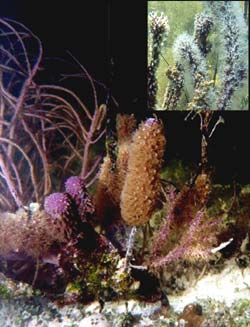Corals can reestablish symbiosis with algae from their environments after bleaching

UB researchers, working with the Caribbean octocoral, Briareum sp., have found that corals can recover from bleaching (inset). <br>Credit: University at Buffalo
Research published in Science demonstrates potential resilience of corals
Corals can develop new symbiotic relationships with algae from their environments after they’ve undergone bleaching, the process by which corals whiten as a result of environmental stress, University at Buffalo biologists report in the current issue of Science.
The research provides evidence that corals may have multiple mechanisms that facilitate recovery from bleaching induced by environmental stresses.
Scientists have known that corals can recover from bleaching episodes, but they did not know why.
It has not been clear whether recovery resulted from the few remaining symbiotic algae, or algal symbionts, remaining within the coral tissue since early development, or if coral could acquire entirely new ones from their aquatic environments.
Corals survive and thrive because of the symbiotic relationship they develop with the single-celled algae called zooxanthellae (zo-zan-thel-y), which live inside them and help supply them with food.
But certain environmental stresses, such as high or low light or sea temperatures, can lead to a reduction in algal densities or loss of pigmentation, leaving the coral’s white skeleton visible through the clear tissue.
“Our data show that corals have the potential to take up new symbionts, providing a mechanism for resilience in the face of environmental change,” said Mary-Alice Coffroth, Ph.D., associate professor of biological sciences in UB’s College of Arts and Sciences, and senior author on the paper.
Coffroth and her co-author, Cynthia L. Lewis, who recently received her master’s degree in biological sciences from UB, induced bleaching in gorgonian soft corals (a type of sea rod common to Caribbean reefs) by keeping them in darkness in the laboratory.
After 12 weeks of darkness, cell densities of symbionts in the coral had plunged to less than one percent of their population density when the corals were healthy.
During the six weeks following ’bleaching,’ the corals were exposed to algal symbionts that were added to the aquarium water.
The researchers found that at the end of this period, symbiont cell densities within the coral showed a significant increase, demonstrating that the coral animals were able to establish symbiotic relationships with these new, or exogenous, algae.
“We found cell densities within the coral had increased between nine and 31 times the level measured immediately following the bleaching episode,” said Lewis.
“The symbiosis had begun to reestablish itself,” added Coffroth.
The UB researchers caution that the survival of individual colonies and populations of coral should not be construed as a demonstration that an entire ecosystem is healthy.
“Nevertheless, these data demonstrate that these animals may have the resilience to recover from bleaching episodes,” said Coffroth.
The coral used in the research was harvested from the Florida Keys National Marine Sanctuary and the laboratory work was conducted at the Keys Marine Laboratory in Long Key, Florida.
The work was supported by grants from the National Science Foundation.
The University at Buffalo is a premier research-intensive public university, the largest and most comprehensive campus in the State University of New York. UB’s more than 27,000 students pursue their academic interests through more than 300 undergraduate, graduate and professional degree programs.
Media Contact
All latest news from the category: Ecology, The Environment and Conservation
This complex theme deals primarily with interactions between organisms and the environmental factors that impact them, but to a greater extent between individual inanimate environmental factors.
innovations-report offers informative reports and articles on topics such as climate protection, landscape conservation, ecological systems, wildlife and nature parks and ecosystem efficiency and balance.
Newest articles

Recovering phosphorus from sewage sludge ash
Chemical and heat treatment of sewage sludge can recover phosphorus in a process that could help address the problem of diminishing supplies of phosphorus ores. Valuable supplies of phosphorus could…

Efficient, sustainable and cost-effective hybrid energy storage system for modern power grids
EU project HyFlow: Over three years of research, the consortium of the EU project HyFlow has successfully developed a highly efficient, sustainable, and cost-effective hybrid energy storage system (HESS) that…

After 25 years, researchers uncover genetic cause of rare neurological disease
Some families call it a trial of faith. Others just call it a curse. The progressive neurological disease known as spinocerebellar ataxia 4 (SCA4) is a rare condition, but its…





















